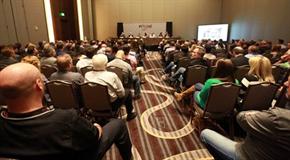Bands, Brands & High Finance
“It’s easier to get sponsorships at a much earlier stage today than it’s ever been – sometimes before you ever have a label deal in place if you’re presenting the right kind of image, the right kind of energy.” Loeb & Loeb’s John Frankenheimer said. “The independent world has really captured that in a much more aggressive way than people might have imagined a few years ago.”
Banks are another way that young acts can secure funds for touring, surprisingly enough.
City National Bank’s Holly Bell explained how banking relationships with artists have changed over the last few years, to the point where “we do sit down and work with young artists that don’t have deals. We’ll talk to them and give them a credit card so they can buy gas, get in a van and go to the venue.”
Bell also highlighted the roles that some of her other clients – – wealthy patrons – play in artist development.
“Can I invite all these people to our baby band showcase this evening?” WME’s Jay Williams quipped. “I need a wealthy patron.”

Unfortunately wealthy benefactors seem to be few and far between, so Vector Management’s Ken Levitan spelled out how he turns over every stone to find money for young artists.
“It’s finding your artist syncs. You may go to ASCAP or BMI. You’re working with your label partner, booking agency or going to events to try to find people who will give you something to put your artist on the road,” he said. “From a low finance side, CAA just brought one of my young clients a potential offer where it’s tied in with a hotel chain. They have to do some tweeting and an afternoon show … but they get a handful of rooms every night in a hotel chain. That saves a lot of money.”
The Messina Group / AEG Live’s Ali Harnell wondered how to find sponsorships that are the right fit.
CAA’s Martha Ivester answered that not all sponsorships are created equal, and some can help artists through the times when they’re not on the road generating revenue.
“That’s when we can bring in a brand to the table that helps them get through that period and also keeps them active in the minds of consumers,” she said. “It may be a partnership that has a media component so it’s getting their face and image in the market when they’re not out there physically. … Artists are seeing there’s a lot of benefits, whether it’s burritos or whether it’s dollars that go to a video production crew that creates content that then becomes a part of the artist’s archive of a moment in their life.”
But when a sponsorship fails, it can fail royally.
Williams recounted one deal that was a disaster from the beginning.
“I had one particular artist who’s not very sponsorable that I work with,” he said. “We did accept a sponsorship from a beer company and at a meet and greet somebody said something to him that he didn’t like. He decided two weeks in there would be no more meet and greets with said sponsor.”
Even if sponsorships don’t fail on such an epic level, sometimes it can be hard to give brands the exclusive content they’re seeking, HUKA Entertainment’s A.J. Niland noted.
“A lot of times there’s conflicting deals with brands that acts have on their tours,” he said, noting that sponsors are often willing to throw around more cash for meet and greets and backstage performances – even with smaller acts.
Frankenheimer and Ivester drove home the importance of artists finding passionate advocates and putting strong teams in place to make brands feel safe partnering with “the next big thing.”
“So often, we make the case based on the team behind the artist,” Ivester said. “A lot of people are out there, but this artist has a great team behind them so trust us, put your dollars there.”
 Daily Pulse
Subscribe
Daily Pulse
Subscribe

